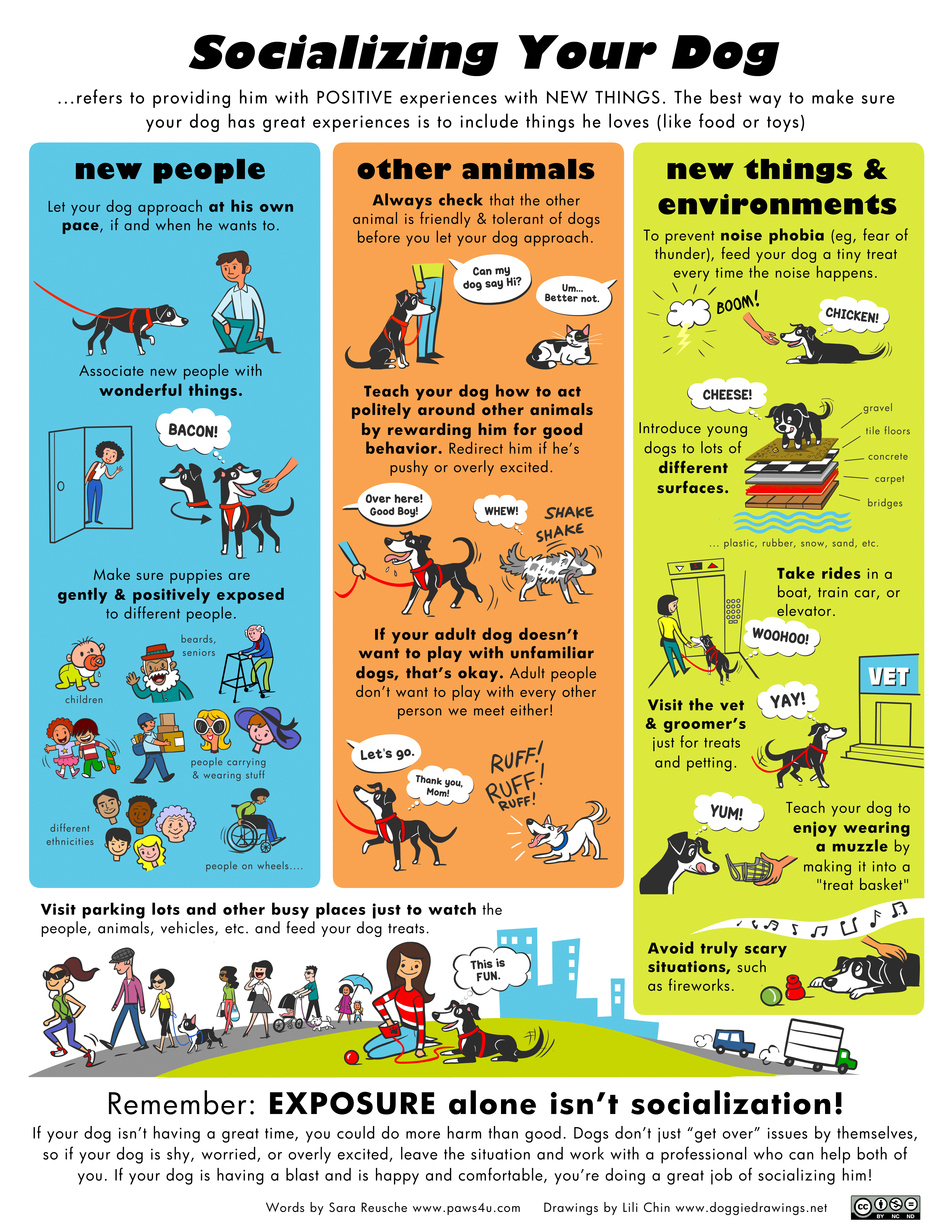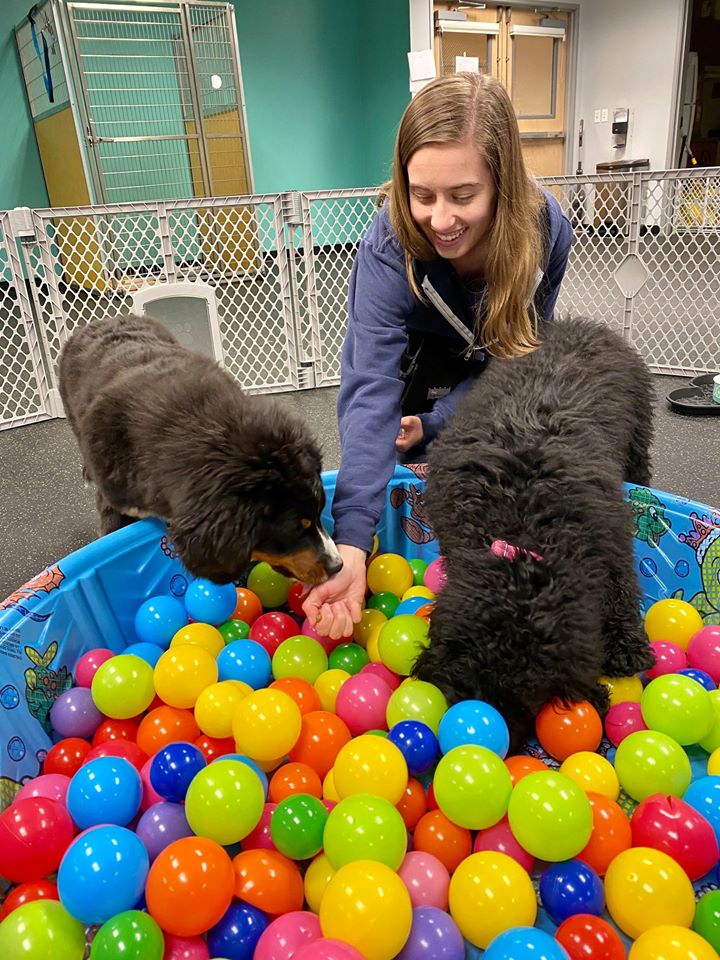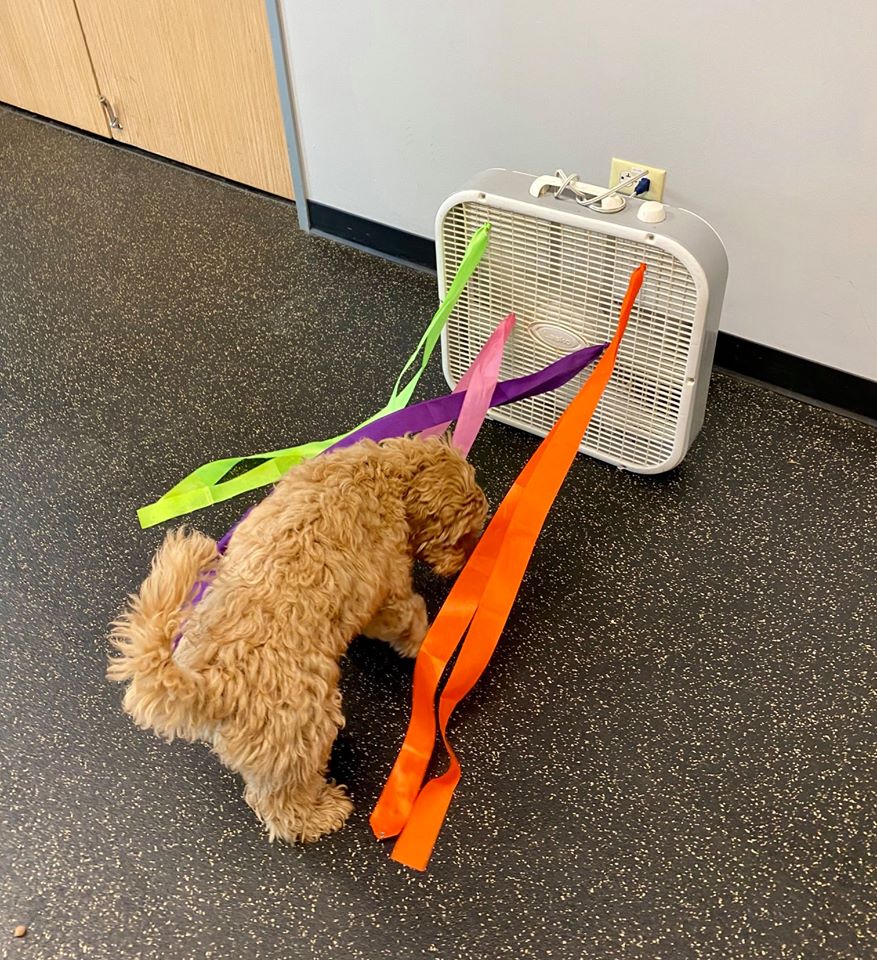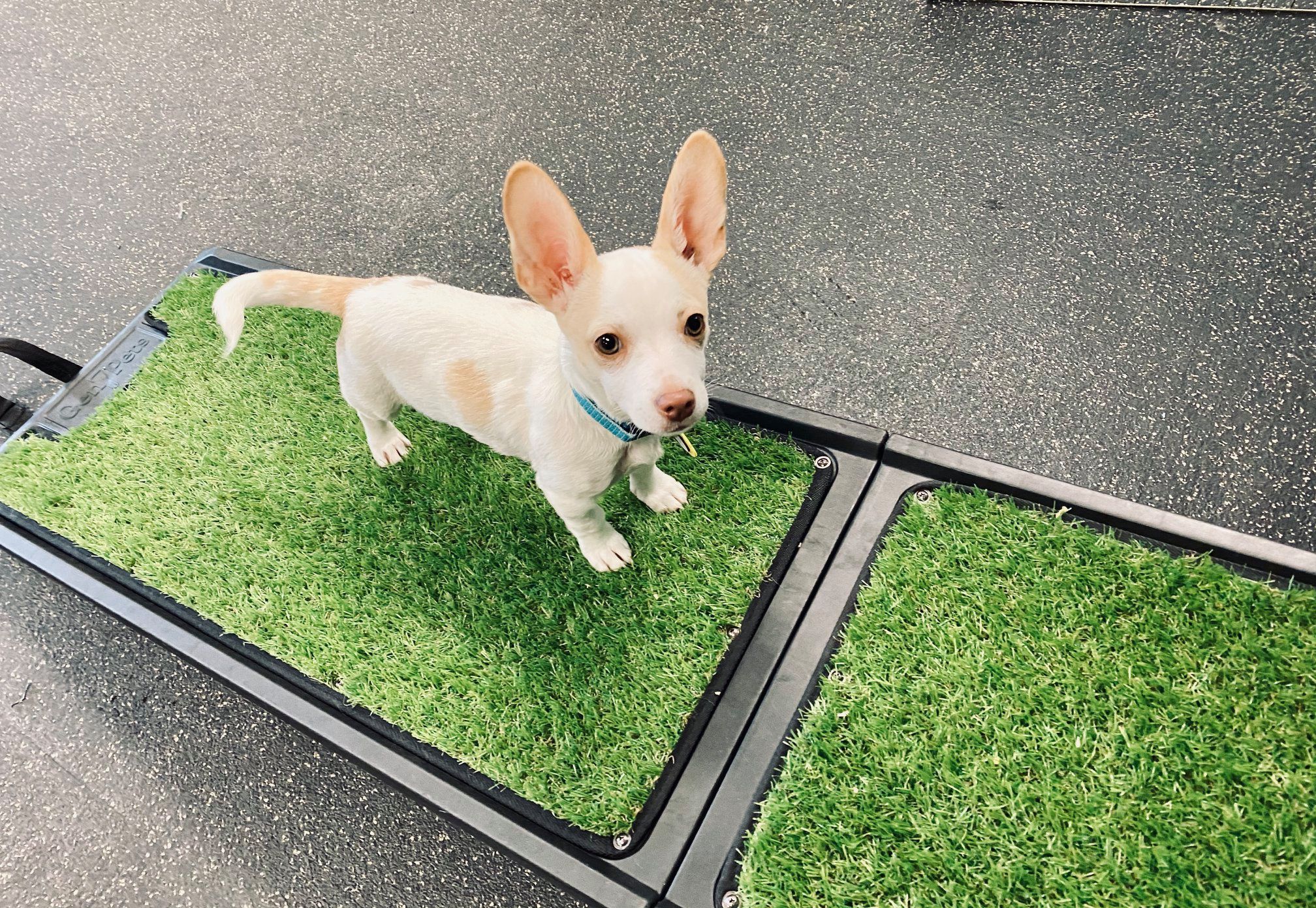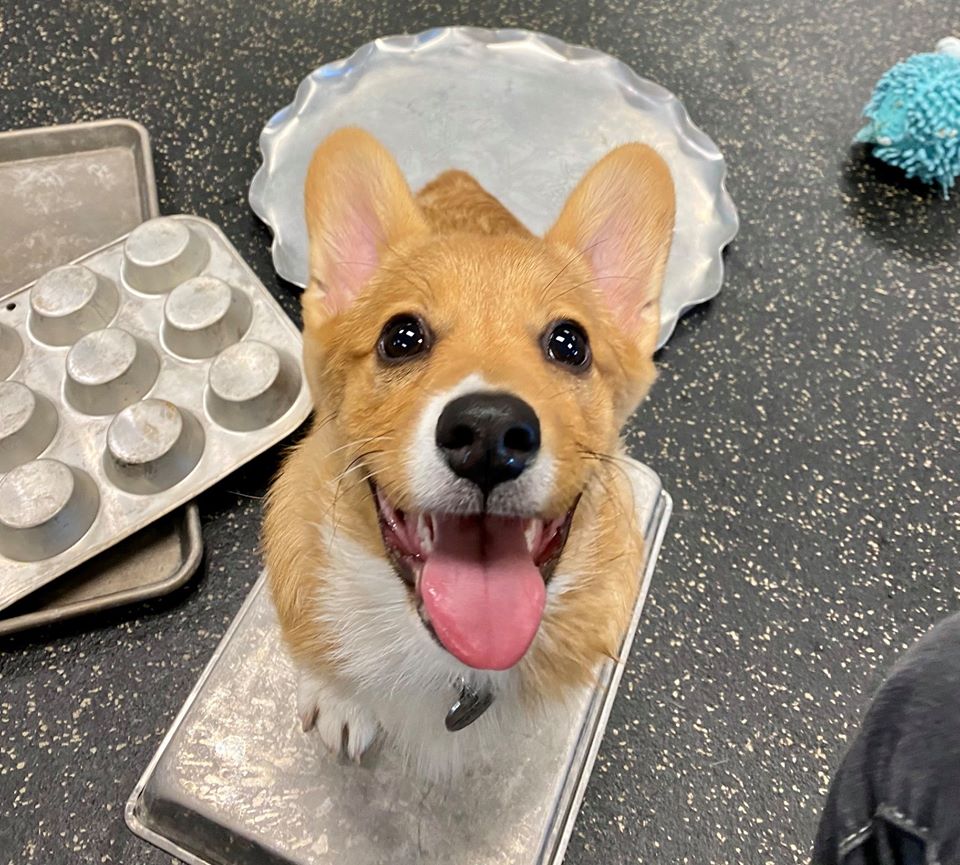Allison Hartlage, CTC, KPA-CTP, CBCC-KA, CNWI
Manager of Animal Training & Behavior
Well, here we are, 11 months later, and still in the midst of a pandemic. One silver lining has been the increase in adoptions of pets nationwide, and decrease in animals seeking a new home. We are so excited that animals and people are benefitting from one another at this time! Many families have chosen puppies as their newest pets – who could blame them? Until we are able to hug and connect (in-person) with our friends and loved ones, puppy snuggles, walks, and playtime sound alright to me! Actually, puppy snuggles always sound alright to me! 🙂 We hope this article will serve to assist you in helping your puppy to mature into the happiest, healthiest version of themselves.
In “Part 1: Socially-distanced socialization,” we explore the importance of creating safe, positive, new experiences for our puppies, especially during their most formative period, from 8-16 weeks old. While many excellent, certified, force-free trainers are once again offering puppy socialization (yay!), challenges still exist in socializing at home during a time of disruption from your normal. In this article, we will work on setting your puppy up for success in and around your home with new people.
A few reminders to help you on your socialization journey:
- Sign up for in-person/drop-off, off-leash puppy socialization opportunities available to you by a certified, force-free trainer. If you live in Boulder or the surrounding area, consider attending HSBV’s Puppy Club or Puppy Prep School.
- Check out “Doggie Language” by Lili Chin and begin to familiarize yourself with what dogs are saying through subtle and overt changes in body language. Our dogs are talking all of the time, but we need to learn their language. Being able to understand subtle signs of discomfort will allow us to better understand our dog’s needs without them having to be increasingly overt in helping us to understand.
- Don’t forget to give yourselves a break! Even though we may be home a lot right now, it is critical to encourage and reinforce moments of alone time for your puppy. Now is the perfect time to introduce them to their crate in small doses so they find comfort in their safe space! Refer to our post on thoughtfulness around possible prevention of separation anxiety and plan to regularly leave your puppy by themselves for short periods of time.
Real challenges and gaps exist when socializing a puppy during a pandemic. Particularly, puppies raised during the pandemic typically aren’t exposed to having visitors to their home, especially strangers in or near their home.
How can you overcome in-home stranger danger?
It makes a lot of sense why pandemic puppies aren’t familiar with people coming to or into their homes, we’re probably a little out-of-practice ourselves. With that said, many of us can’t wait to have our friends and family visit again, so our puppies should be set-up for success here.
- Prime time to take advantage of all of those deliveries! Pair high-value treats (chicken, cheese, hot dogs, etc.) with the sight or sound of anyone approaching or visiting your porch or home. Ideally, begin feeding your dog the moment they notice the visitor (before they begin barking, if that’s their MO). If they’re barking, can you wait for a split-second of quiet between barks to feed? If so, you can begin to delay the onset of the treat by just a tiny bit to get more and more quiet each time. If your dog appears visibly upset by the presence of new people approaching your home, please contact a certified, force-free, reward-based trainer for individualized help.
- Treat your neighbors! Leave baked goods or a favorite beverage of choice on your porch for any well-deserving family, friends, or neighbors who agree to knock on your door or ring your doorbell. If it is safe, and you have an exterior screen or glass door on your front door, consider opening it (if your puppy is comfortable!) so they can see their new friends, while still maintaining your distance from your visitors. The goal is always that the experiences are:
- POSITIVE: Your puppy is happy, comfortable enough to eat and is displaying neutral or social body-language (loose, wiggly, open mouthed, joyful).
- DIVERSE: We want people who look different from one another to help with this game. Think children and adults, men with facial hair and without, hats, jackets, people of varying ethnicities if possible, costumes, etc.
- NOVEL: The same gold-star earning neighbor time after time isn’t enough. We need lots of new people and dogs so that your pup learns “people are good!”
- Recruit window-wavers. Have your helper approach your home so that your puppy can see them from your window. As soon as your puppy notices them – TREATS! – feed your puppy! Keep sessions short and positive – your puppy should be relaxed and having fun.
- Social hour: meet-and-treat from the porch! Place a bowl of high-value treats on the pathway up to your porch or door at least six feet away from where you and your puppy will be stationed. Have your masked neighbors and friends approach that bucket, grab a few treats and toss them to your pup. If your puppy looks comfortable, loose, waggy and excited, they can repeat this several times. If your pup barks, backs away, growls, cowers, tucks their tail, pins ear or expresses concern in any way, have your helper stop far enough away from you where your pup does not display this body language and toss from there. Repeat this with lots of different people, dressed in lots of different ways – ski goggles, back-packs, big coats, carrying/rolling different things (bikes, wagons, etc.).
- Backyard buddies: Pretend your backyard gate is your front door. Head into your yard with high-value treats (do you see a theme here?). Have your masked helper approach and knock on your fence as though it were a door to your home. Feed your pup after the knock. If your puppy looks comfortable, have the person enter, then you can feed your dog again when they notice the person. If this goes well, leave a bowl of high value food (or your dog’s favorite toy) outside the fence. Hang out in your yard with your dog leashed. Have your helper enter your yard “unexpectedly” (at least to your dog) and toss treats or their toy to them. To know this is working the way we want it to, your puppy should be loose, waggy, wiggly or excited looking when they notice the new person. If this all looks good, repeat with lots of people like above.

